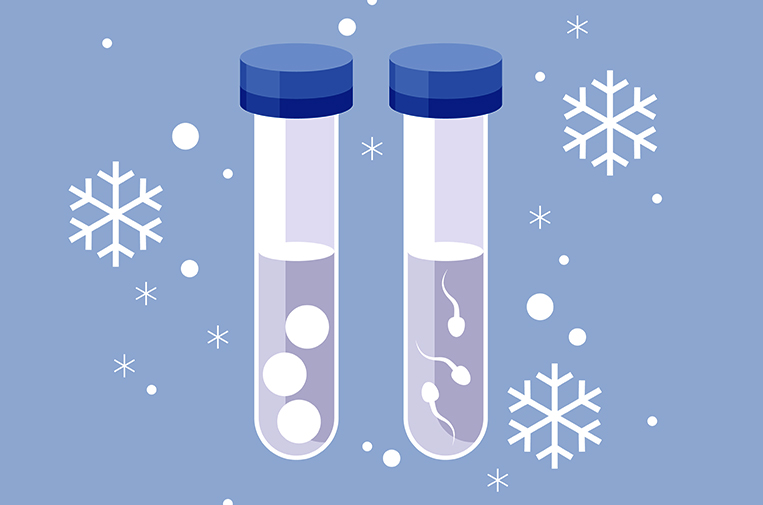Understand the pros and cons of the medicated frozen embryo transfer and natural frozen embryo transfer protocols to prepare the endometrium to receive the IVF embryo.
If you are planning for a frozen embryo transfer (FET), you should know that the two types of treatment protocols utilize either a medicated cycle or a natural cycle. A cycle refers to one round of in vitro fertilization (IVF) treatment, and an embryo transfer cycle refers to one attempt at embryo transfer.
Both medicated and natural frozen embryo transfers involve providing your uterus with estrogen to thicken the endometrial lining and then adding progesterone for a fixed amount of time to induce changes in the endometrium to make it “receptive” to an embryo.
However, the medicated and natural cycles provide these two hormones in different ways. Fortunately, our data from the Reproductive Science Center of the San Francisco Bay Area shows that pregnancy rates are similar after both types of cycles. So, this article is aimed at explaining each protocol further, and helping you decide which protocol is right for you.
Medicated frozen embryo transfer cycles
In the medicated cycle, also called a controlled cycle or programmed cycle, your body relies entirely on estrogen and progesterone medications to prepare the uterus for embryo transfer. Estrogen, usually in the form of an oral pill but sometimes via patch or vaginal administration, is taken for approximately 2-3 weeks. Then, an ultrasound is done to ensure the endometrial lining is adequately thick and developed. If not, the estrogen dose is increased, and a repeat ultrasound is performed in a few days.
If the endometrial lining is adequate, progesterone medication is started, via daily vaginal suppositories and intramuscular injection, exactly 6 days before a scheduled frozen embryo transfer. Both estrogen and progesterone are continued for approximately 6-7 weeks after the embryo transfer.
Pros of the medicated frozen embryo transfer
- Requires fewer visits for monitoring and bloodwork, typically just one visit for measurement of the endometrial lining.
- Given that the administration of medications is controlled and scheduled, the date of an embryo transfer can be chosen around your work schedule/availability, or that of your doctor to ensure they perform your embryo transfer.
- Because estrogen levels can be made higher than in a natural cycle, this is a good option for patients who have struggled with a thin lining in the past.
Cons of the medicated frozen embryo transfer
Requires more medications than a natural cycle, including daily intramuscular progesterone injections.
Natural frozen embryo transfer cycles
In a natural frozen embryo transfer cycle protocol, estrogen and progesterone are “naturally” produced by your body during the process of ovulation. Estrogen levels rise steadily in the first half of the cycle. Then, when ovulation occurs and a corpus luteum is created, progesterone starts to be produced and an embryo transfer is scheduled for 6 days later.
To ensure that the embryo transfer is scheduled relative to the time of ovulation as closely as possible, this protocol requires frequent (sometimes daily) monitoring after cycle days 9-10 to capture when ovulation will occur. Specifically, monitoring is aimed to assess for the luteinizing hormone (LH) “surge” that precedes ovulation by 24 hours.
Variations of a natural frozen embryo transfer cycle can add some predictability and convenience. An ovulation induction medication called letrozole can be taken for 5 days at the beginning of a cycle to almost reliably help your body ovulate 5-7 days after finishing the medication. Furthermore, rather than waiting for your body to ovulate naturally, in a “modified” natural cycle, an injection of the human chorionic gonadotropin (hCG) hormone is taken to enact ovulation approximately 36 hours later, and then an embryo transfer is timed accordingly. Both of these strategies can reduce the number of monitoring visits.
Though the progesterone produced by your body is likely sufficient to support implantation and a pregnancy, in any natural cycle we still recommend patients take a vaginal progesterone suppository starting after ovulation and continued for 5-6 weeks after the embryo transfer.
Pros of natural frozen embryo transfer
- Utilizes fewer medications and injections compared to the medicated protocol and is therefore more “natural” and easier on the body.
- Research studies show that pregnancies conceived after natural cycles have lower rates of hypertensive disorders including pre-eclampsia.
Cons of natural cycle frozen embryo transfer
- Given this protocol relies on regular cycles, women with very irregular cycles or who are peri-/menopausal and no longer have a cycle are not eligible for this protocol.
- Requires more frequent appointments for monitoring via ultrasound and bloodwork, especially around the time of ovulation. Furthermore, if the timing of ovulation is missed, then a cycle may have to be canceled.
- Given that the day of embryo transfer is determined by the day of ovulation, it can be less reliably scheduled around your convenience and availability. Furthermore, this unpredictability increases the chance that your embryo transfer will be performed by a doctor different than your own.





